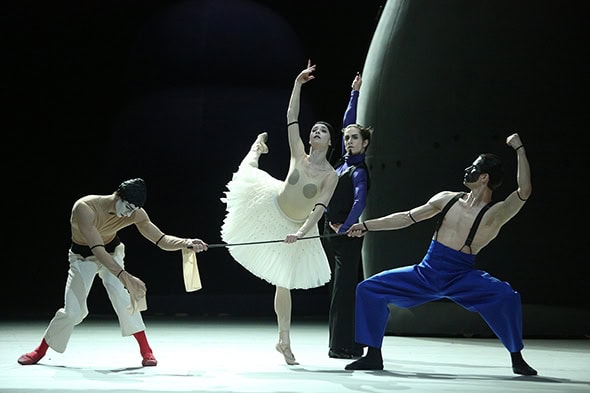The Bolshoi Ballet livestream of Carmen Suite and Petrushka
Posted: June 2nd, 2019 | Author: Nicholas Minns & Caterina Albano | Filed under: Livestream, Performance | Tags: Alberto Alonso, Alexander Rubtsov, Anton Savichev, Boris Messerer, Denis Rodkin, Denis Savin, Edward Clug, Ekaterina Krysanova, Isabelle Julien, Leo Kulaš, Marko Japelj, Martin Gebhardt, Maya Plisetskaya, Mikhail Lobukhin, Olga Marchenkova, Svetlana Zakharova, The Bolshoi Ballet, Vitaly Biktimirov, Vyacheslav Lopatin | Comments Off on The Bolshoi Ballet livestream of Carmen Suite and PetrushkaThe Bolshoi Ballet livestream of Carmen Suite and Petrushka, May 19

In London there is nothing quite like a live performance of classical ballet at the Royal Opera House, the Coliseum or at Sadler’s Wells, but when it comes to seeing the Bolshoi Ballet regularly there is nothing quite like dropping in to a local cinema to see a live-streamed performance. The final program of the Bolshoi’s current season is a double bill of Alberto Alonso’s Carmen Suite and a new version of Petrushka by Edward Clug. Even though the ballets were created in different political climates, both coalesce around a trio of characters in which one risks the ultimate price for freedom. Carmen is released from prison but becomes trapped in her torrid affair with both the corporal, Don José, and the torreador Escamillo; in Petrushka a manipulated doll declares his love for his Ballerina in an effort to establish his humanity.
Alonso created Carmen Suite in 1967 for one of the Bolshoi’s greatest dramatic dancers, Maya Plisetskaya who, at 42, was looking for new expressive challenges; the public success of the ballet was so bound up with her performance of the role that, as compère Katya Novikova tells us, when she retired in 1987 Carmen Suite retired from the repertoire with her. It wasn’t until the appearance of Svetlana Zakharova in 2005 that the ballet was revived. Alonso’s choreographic style is minimal, requiring technical precision and dynamic shapes but the erotic effect of the narrative combined with the thrillingly percussive interpolation of Bizet’s score by Rodion Schedrin are embodied in the presence of the performers. The change in the principal role is more than a change in interpretation; classical technique has developed so far in the last fifty years that it has become a virtual proxy for dramatic intent. Plisetskaya’s performance of Carmen added dramatic expression to her technical prowess whereas Zakharova’s incorporates the drama of Carmen into the refinement of her technique. Applying Roland Barthes’ phrase ‘le grain de la voix’ to the body, Plisetskaya had a rough, almost feral quality that conveyed the character’s instinctive independence, whereas Zakharova has a smooth sensuality that is more individualistic than fiery. Denis Rodkin as Don José matches Zakharova in the elegant muscularity of his technique while Mikhail Lobukhin as Escamillo is more impetuous as if he has just returned from a bull fight. Vitaly Biktimirov as the Corregidor and Olga Marchenkova as Fate complete the main characters. Boris Messerer’s set under Alexander Rubtsov’s lighting is spectacular, a semi-circular performance area with tall-backed chairs on its raised rim that give it is a sense of a bull ring combined with a court chamber. An abstracted head of a bull is suspended over the action. The production, filmed by Isabelle Julien, lends itself beautifully to the cinema screen.
In effect Clug has brought Petrushka back home. Although the scenario of the original version was worked out by Igor Stravinsky and Alexandre Benois in St. Petersburg, Michel Fokine created the choreography in Rome and Paris for Diaghilev in 1911. Under Martin Gebhardt’s lighting, Marko Japelj’s set for this production uses the double symbolism of large-scale coloured Matryoshka dolls to represent the tents at the Butter Week Fair Benois so fondly remembered. As Clug explains in a written interview, ‘I aimed to bring back to life the same story told in a different choreographic language and set in a new theatrical aesthetic…I could feel the importance of Petrushka in Russian culture and even more in the people’s hearts…All the elements involved — sets, costumes, choreography and not least the music — carefully depict elements arising from the Russian folklore and tradition.’ If Benois and Stravinsky conceived Petrushka as the immortal Russian spirit evading its confines, Clug sees him more in contemporary psychological terms where woodenness is an inability to connect; his Petrushka ‘wants to overcome his condition and be able to feel, give and receive real emotions. We humans take this option for granted and so often we throw it away.’ It’s a fresh reading that gives a prominent role to Vyacheslav Lopatin’s Magician, an oppressor who masterminds the relationship between his puppets through the use of magic sticks. Petrushka (Denis Savin) is the rebel because he wants to elevate himself while the beautiful Ballerina (Ekaterina Krysanova) and the boorish Moor (Anton Savichev) succumb to their master’s control. The costumes of Leo Kulaš evoke the principal characters as humans who are reduced to being puppets but at the very last moment Clug casts doubt on who is free and who is being manipulated.